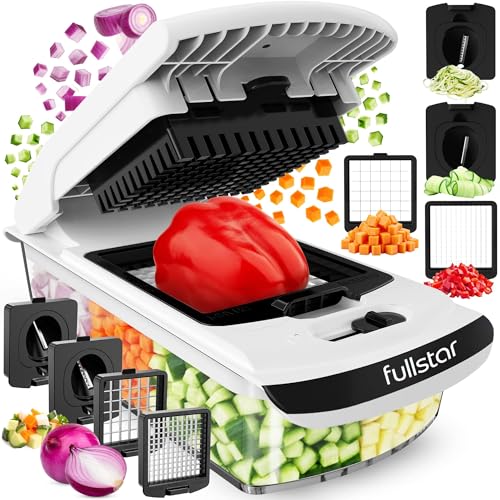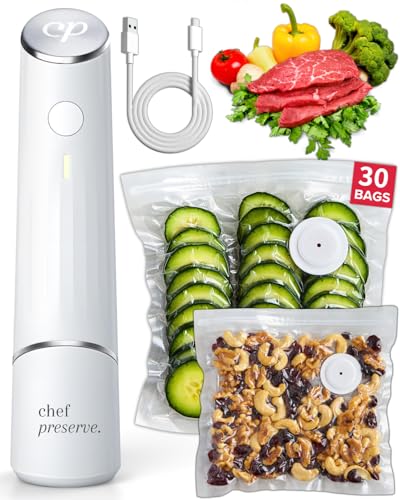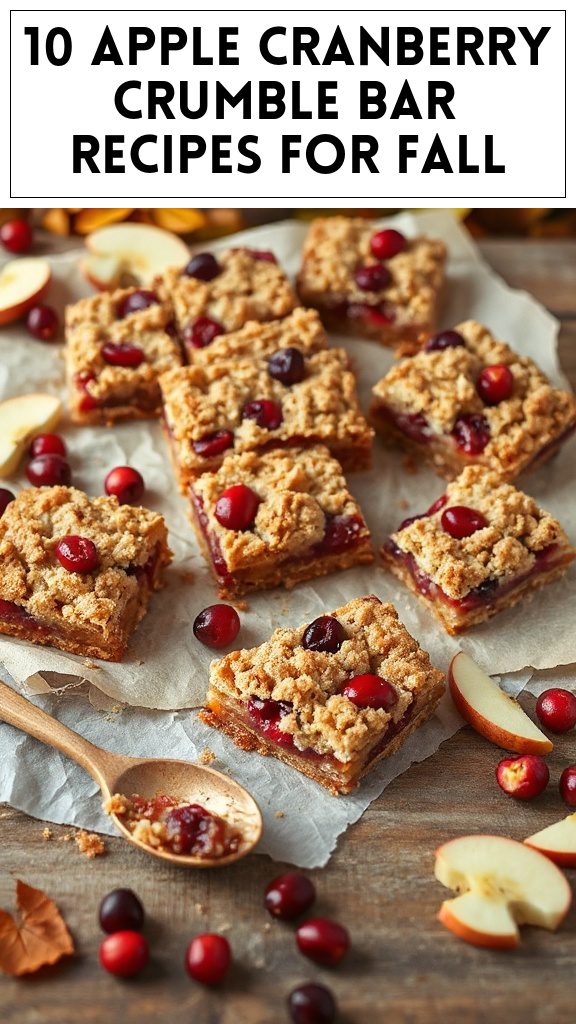Origins of Easter Chocolate
As spring arrives, many people eagerly anticipate the arrival of Easter chocolate, a delightful treat that has evolved over centuries. The origins of Easter chocolate can be traced back to ancient springtime celebrations, where eggs symbolized fertility and renewal.
In the 19th century, as chocolate-making techniques advanced, these symbols transformed into edible delights. The first chocolate eggs appeared in France and Germany, captivating those who enjoyed them as part of Easter traditions.
Initially solid, the chocolate became hollow, allowing for creative fillings and decorations. This innovation ushered in the iconic Easter egg chocolate we know today, merging rich chocolate history with festive customs.
Easter chocolate continues to enchant families, bridging generations while reinforcing the joyous spirit of the holiday.
- The Original Pro Chopper - Our superstar veggie slicer has been creating waves on TikTok! Simple to use,...
- Easy Meal Prep with Rust-Resistant Blades - Our vegetable chopper is perfect for anyone who wants to eat...
- 5-Star Design - The soft-grip TPU handle ensures controlled chopping, while the non-skid rubber base...
Chocolate Lovers of All Ages
Easter chocolate brings together families and friends, creating shared moments of joy that resonate with chocolate lovers of all ages.
From the first bite of creamy milk chocolate to the robust flavors of dark varieties, Easter eggs evoke a sense of wonder. The tradition of chocolate during Easter has deep roots in chocolate history, tracing back to early celebrations tied to fertility and rebirth.
Today, these exquisite confections symbolize the transitional spirit of spring, captivating both children and adults alike.
Homemade Easter chocolate eggs allow families to engage in meaningful activities, fostering creativity and collaboration. As children eagerly participate in decorating and filling eggs, they inherit cherished Easter traditions, ensuring that the love for chocolate continues to thrive through generations.
- Makes Everything Simple : Just forget your bagged cheese! Only turn the handle for several times and get...
- Premium Material : All parts of the rotary cheese grater are made of food grade ABS material, no BPA. The...
- Three Option Grater : The parmesan cheese grater finishes food preparation with slicing, shredding and...
Essential Ingredients
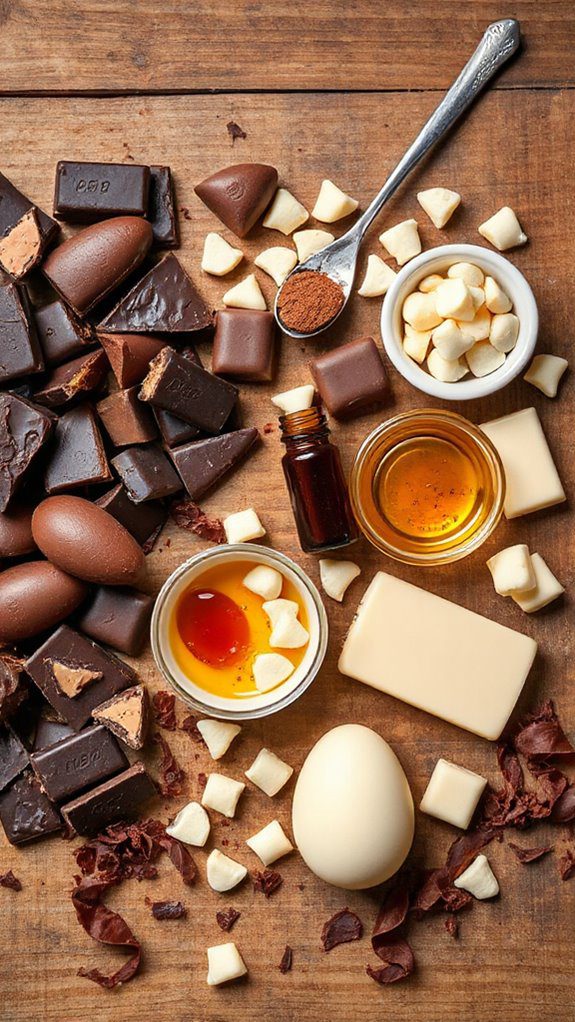
While crafting homemade Easter chocolate eggs, the choice of ingredients plays a crucial role in achieving rich flavor and texture.
The foundation lies in selecting the right chocolate types, each with distinct flavor profiles. Dark chocolate offers intense cocoa notes and a hint of bitterness, perfect for those who enjoy robust flavors. Milk chocolate, on the other hand, provides a creamy sweetness that appeals to a broader audience. White chocolate, while technically not chocolate, adds indulgent richness and can serve as a delightful base for fillings.
Additionally, incorporating high-quality flavorings such as vanilla extract or flavored oils can elevate the overall taste experience. Quality ingredients not only enhance the flavor but also ensure a smooth and satisfying texture for these festive treats.
- 💰 REDUCE WASTE AND SAVE MONEY: Chef Preserve keeps FOOD FRESH 5 TIMES LONGER than non-vacuum storage...
- ✅ POWERFUL, QUICK & EASY TO USE: Simply press the button to start. The device vacuum seals a bag in 5...
- ♻️ REUSABLE & RESEALABLE BAGS: Chef Preserve comes with dishwasher, freezer, refrigerator, and...
Cooking Steps
Having gathered high-quality ingredients to craft delightful homemade Easter chocolate eggs, the next step involves a series of straightforward yet important cooking processes.
First, tempering the chocolate is essential; this ensures a glossy finish and perfect snap. After melting the chocolate, it should be cooled slightly before coating silicone egg molds. Each mold is then filled, ensuring even coverage.
After allowing the chocolate to set, a second layer can be added for sturdiness. Once cooled completely, the eggs can be elegantly filled with various delights such as cream or caramel.
Finally, the true fun begins with egg decorating; vibrant colors and creative designs enhance the festive spirit and uphold cherished Easter traditions, making these homemade treats truly special.
- Generous Capacity: 7-quart slow cooker that comfortably serves 9+ people or fits a 7-pound roast
- Cooking Flexibility: High or low slow cooking settings, with convenient warm function for ideal serving...
- Convenient: Set it and forget it feature enables you to cook while at work or performing daily tasks
1. Prepare Flour Mixture Thoroughly
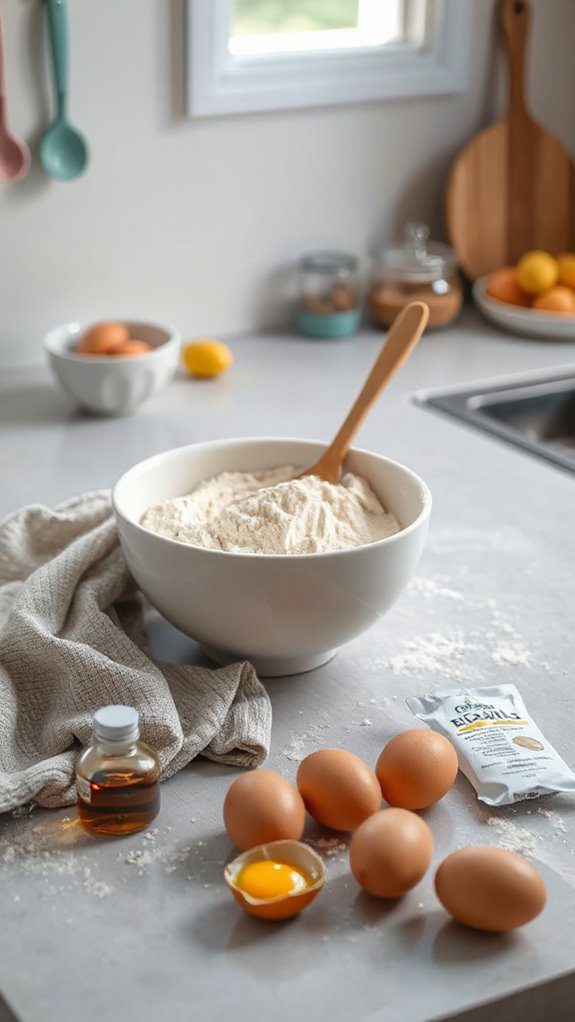
Creating a well-balanced flour mixture is a crucial step in the preparation of homemade Easter chocolate eggs. The choice of flour greatly influences the texture and taste of the final product.
For those seeking gluten-free options, almond flour or coconut flour can serve as excellent flour substitutes, providing both flavor and structure. It’s essential to measure these alternatives accurately, as their absorbency can differ significantly from traditional flour.
Blending gluten-free flour with a binding agent, like xanthan gum, ensures a cohesive mixture that holds together during molding. This careful preparation not only enhances the chocolate egg’s integrity but also caters to a variety of dietary preferences, making these homemade treats enjoyable for everyone, regardless of their gluten sensitivities.
- 100% Leak-proof: Guaranteed no-spill seal and secure latches
- Crystal-clear Tritan Built: Stain-resistant and odor-resistant material for a clear view of contents
- Lightweight & Sturdy: Easy to carry, yet durable for everyday use
2. Mix Wet Ingredients Well

To achieve a harmonious blend of flavors in homemade Easter chocolate eggs, thoroughly mixing the wet ingredients is essential.
The key lies in understanding the appropriate ingredient temperatures, as room-temperature eggs and milk combine more easily, ensuring a smooth mixture.
Employing effective mixing techniques, such as whisking or using a hand mixer, helps break down fat and dissolve sugar, resulting in a light, airy batter.
The goal is a homogeneous blend where each ingredient is well-integrated, allowing the rich flavors of chocolate to shine through.
Careful attention to this step creates a foundation for delightful chocolate eggs that are both tastefully rich and beautifully textured, ensuring they surpass any store-bought equivalents.
- 𝗘𝗳𝗳𝗼𝗿𝘁𝗹𝗲𝘀𝘀 𝗪𝗲𝗶𝗴𝗵𝗶𝗻𝗴: Supports 5 units...
- 𝗣𝗿𝗲𝗰𝗶𝘀𝗲 𝗥𝗲𝘀𝘂𝗹𝘁𝘀: Accurately weighs up to 11 lb/5 kg with 1 g...
- 𝗦𝗶𝗺𝗽𝗹𝗲 & 𝗖𝗼𝗺𝗽𝗮𝗰𝘁: The small and sleek scale is a perfect fit for...
3. Fold in Fruits or Nuts

Incorporating fruits or nuts into the chocolate egg mixture elevates both the flavor profile and texture, transforming a simple treat into an indulgent delight.
A wide range of fruit varieties can be used, such as dried cherries, apricots, or zesty orange peel, each contributing its unique sweetness and tang. These fruits not only enhance the chocolate’s richness but also provide a delightful chewiness that contrasts beautifully with the smooth, velvety chocolate.
Meanwhile, nut selections, like crunchy pistachios or classic hazelnuts, add satisfying texture and a nutty depth of flavor.
The harmonious combination of these elements creates a decadent chocolate egg that tantalizes the palate, ensuring that homemade creations stand out far beyond their store-bought counterparts, embodying a true artisanal experience.
- Instant Read Food Thermometer | Our instant read thermometer features a temperature probe and advanced,...
- Multi-Use | From bbq thermometer to baking thermometer, our digital food thermometer for cooking is...
- Easy-Read Digital Thermometer For Cooking | Large instant thermometer dial with bright blue backlight...
4. Pour Batter Into Pan
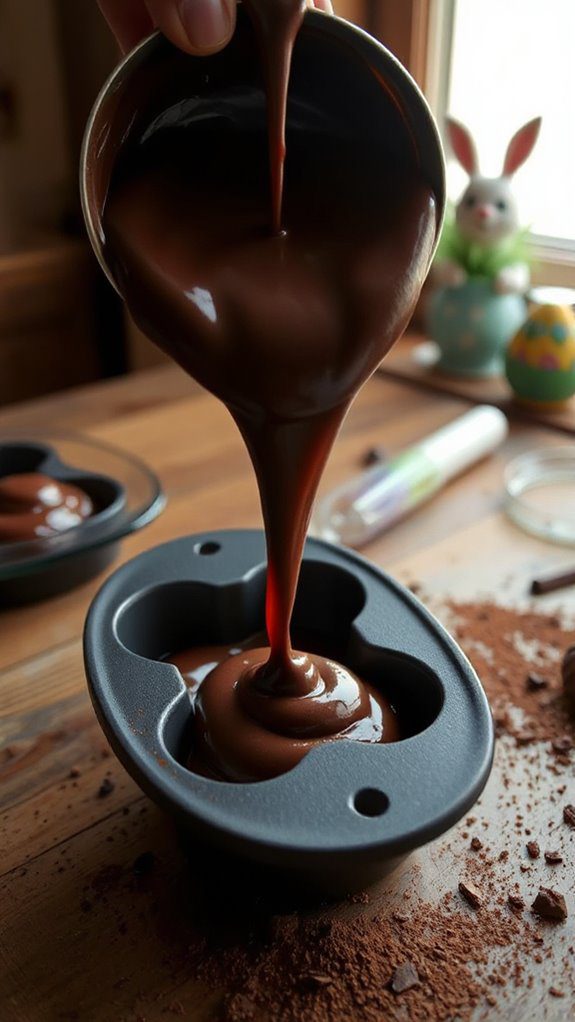
With a gentle tilt of the mixing bowl, the luscious batter cascades into the prepared loaf pan, filling it with a promise of deliciousness.
The baker pays close attention to the batter consistency, ensuring it flows smoothly without being too runny or thick.
Utilizing a precise pouring technique, they guide the batter toward the center of the pan, creating an even distribution.
As the mixture settles, it gently fills every nook and cranny, minimizing the chance of air pockets.
A spatula swipes across the surface, smoothing the top to perfection, readying it for the oven’s embrace.
This careful process transforms the ingredients into a harmonious blend, setting the stage for an delectable homemade treat that surpasses anything store-bought.
- Versatile 54-Piece Collection: Elevate your kitchen with the Home Hero 54-Piece Kitchen Utensil Set, a...
- Durable and Long-Lasting: Crafted from premium stainless steel, these kitchen utensils are designed to...
- Perfect Holiday Gift: Delight your loved ones with this kitchen utensils gift set this festive season....
5. Bake Until Golden Brown
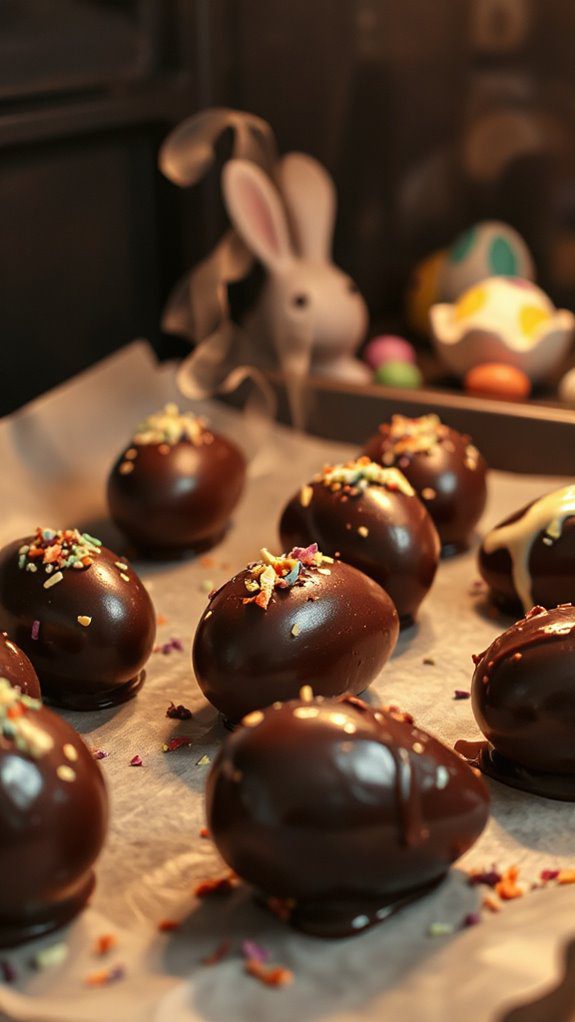
As the prepared batter sits patiently in the loaf pan, anticipation builds for the baking process to commence. The oven, preheated to a steady 350°F (175°C), radiates warmth, ready to transform the mixture into a delightful treat.
After about 45-50 minutes, an irresistible aroma fills the kitchen, hinting at the magic unfolding inside. The key to achieving a beautiful golden crust lies in perfect timing; a toothpick inserted into the center should emerge clean, signaling readiness.
As the timer ticks down, vigilance is essential—overbaking can ruin that sought-after texture. Once the baking completes, the loaf emerges, its exterior glistening with promise and flavor, enticing all who wander near to savor the homemade goodness that awaits.
- 24-ounce insulated stainless-steel water bottle with a FreeSip spout and push-button lid with lock
- Patented FreeSip spout designed for either sipping upright through the built-in straw or tilting back to...
- Protective push-to-open lid keeps spout clean; convenient carry loop doubles as a lock
6. Cool on Wire Rack
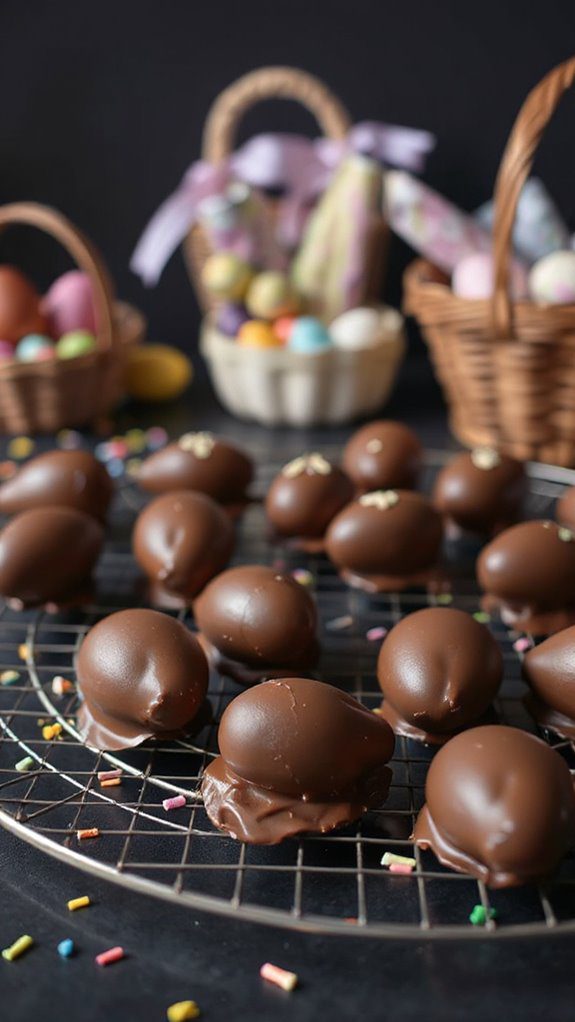
Gently releasing the warm loaf from its pan, the baker transfers it to a wire rack for cooling.
This crucial step in the baking process utilizes effective cooling techniques, allowing air to circulate around the loaf. As it rests on the wire rack—a preferred baking surface—the excess moisture escapes, ensuring a firm and crusty exterior.
The cooling rack’s elevated design prevents condensation from forming underneath, preserving the loaf’s texture and flavor. While it cools, the tantalizing aroma fills the kitchen, enticing those nearby.
Timing is key; allowing the loaf to cool completely before slicing helps maintain moisture and alignment of flavors. Mastering this simple technique enhances the overall quality of baked goods, transforming them into delightful treats.
7. Flavor Combinations for Serving

While the freshly baked loaf cools, the possibilities for flavor combinations come to life, transforming it into a versatile centerpiece for any Easter gathering.
One enticing option involves pairing rich dark chocolate with a tangy raspberry filling, creating a delightful contrast that tantalizes the taste buds. For those seeking a more adventurous flavor, consider a combination of silky milk chocolate and a hint of chili, offering a surprising kick.
Unique fillings such as lavender-infused white chocolate or pistachio cream allow for endless creativity. To enhance the experience further, choose complementary chocolate pairings like caramel or almond, elevating each bite to new heights.
Each combination not only captivates the palate but also sparks joy in the celebration of Easter.
Serving and Pairing Suggestions
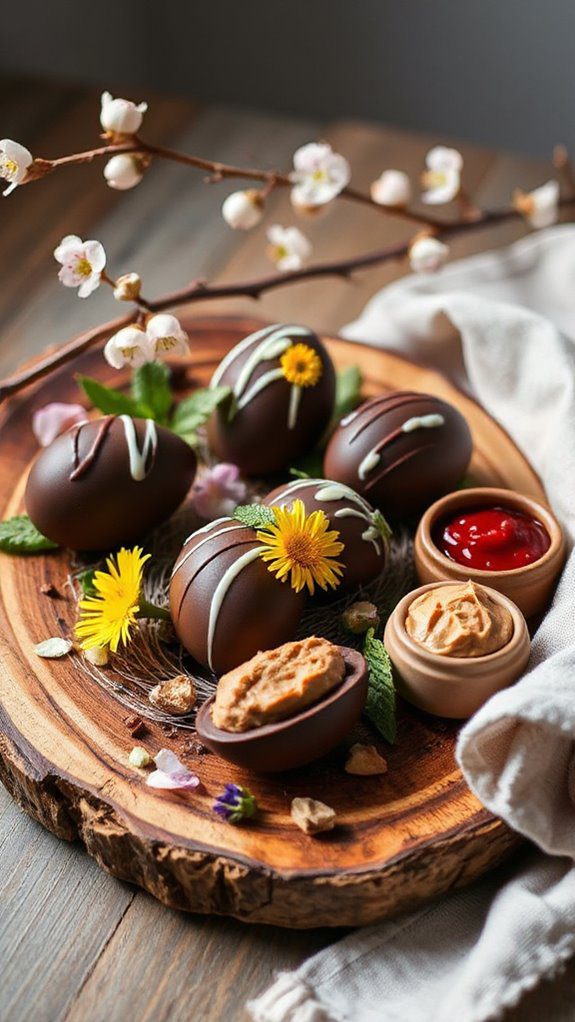
Often, serving homemade Easter chocolate eggs can be an inviting experience that elevates any gathering.
To enhance the enjoyment, consider various chocolate pairings and creative serving styles.
- Pair with fresh strawberries or raspberries for a burst of acidity.
- Offer alongside a selection of gourmet cheeses to balance sweetness.
- Serve with hot coffee or espresso, which complements the rich flavors.
- Create a dessert platter featuring assorted nuts and dried fruits for added texture.
- Present in decorative bowls or egg cartons for a unique visual display.
These thoughtful combinations not only highlight the homemade chocolate eggs but also create a cohesive dining experience that encourages tasting and sharing among guests.
Tips and Variations
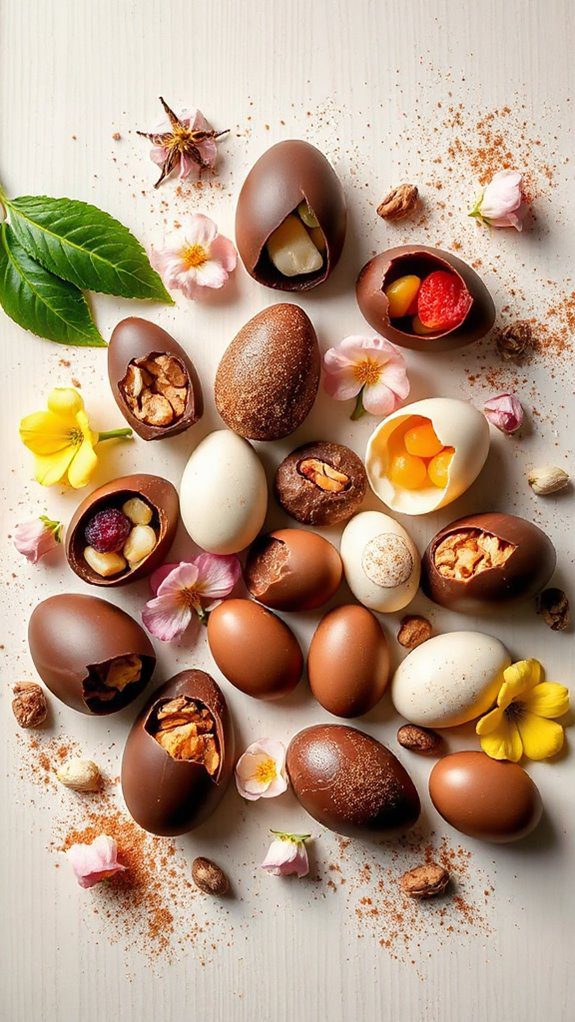
Creating homemade Easter chocolate eggs offers a delightful opportunity for personalization and creativity in the kitchen. With a variety of tips and variations, these chocolate confections can become unique masterpieces.
- Experiment with creative fillings such as peanut butter, raspberry ganache, or nougat.
- Use assorted chocolates—dark, milk, or white—to craft a flavor profile that pleases everyone’s palate.
- Incorporate decorative designs with edible glitters, colorful sprinkles, or even intricate piping.
- Experiment with flavoring the chocolate by adding ingredients like orange zest or mint extract.
- Consider the size and shape of the molds to create eggs that are large, small, or even filled with surprises.
These variations encourage everyone to unleash their inner chocolatier this Easter.
Kitchen Tools
To successfully craft homemade Easter chocolate eggs, having the right kitchen tools at hand is crucial for achieving the desired results. Quality kitchen gadgets and baking tools streamline the process, ensuring that each egg turns out beautifully.
| Essential Tools | Purpose |
|---|---|
| Silicone Molds | Shape the chocolate eggs precisely |
| Double Boiler | Melt chocolate evenly without burning |
| Whisk | Blend ingredients and temper chocolate |
The right molds provide the perfect form, while a double boiler aids in achieving the optimum melting temperature for chocolate. A simple whisk is essential for ensuring uniform mixtures. Utilizing these tools not only enhances efficiency but also elevates the overall homemade chocolate egg experience.
Essential Equipment
When embarking on the delightful journey of making homemade Easter chocolate eggs, the right essential equipment can make all the difference between a frustrating experience and a joyful one.
Below is a list of indispensable items needed to ensure success:
- Chocolate molds: Explore various molds options to create fun shapes and sizes.
- Double boiler: Crucial for chocolate tempering, preventing seizing or burning.
- Thermometer: Helps monitor the exact temperature during the tempering process.
- Piping bags: Useful for filling molds with precision and providing artistic flair.
- Spatula: Essential for smoothing chocolate and scraping every last drop from bowls.
With these tools at hand, crafting delicious chocolate eggs becomes a rewarding and enjoyable task.
Nutritional Information (Estimated, per serving)
Understanding the nutritional information of homemade Easter chocolate eggs allows individuals to enjoy their treats with a sense of balance. These delightful confections not only satisfy sweet cravings but also offer nutritional benefits when made thoughtfully.
| Nutrient | Amount per Serving | Percentage of Daily Value (%) |
|---|---|---|
| Calories | 150 | 7 |
| Total Fat | 8g | 12 |
| Sugars | 15g | 30 |
| Protein | 2g | 4 |
With a typical serving size in mind, individuals can appreciate the richer flavors while being mindful of their dietary choices. Homemade varieties may allow for healthier substitutions, thus uniquely tailoring indulgence to personal preferences and nutritional goals.
Related Festive Treats
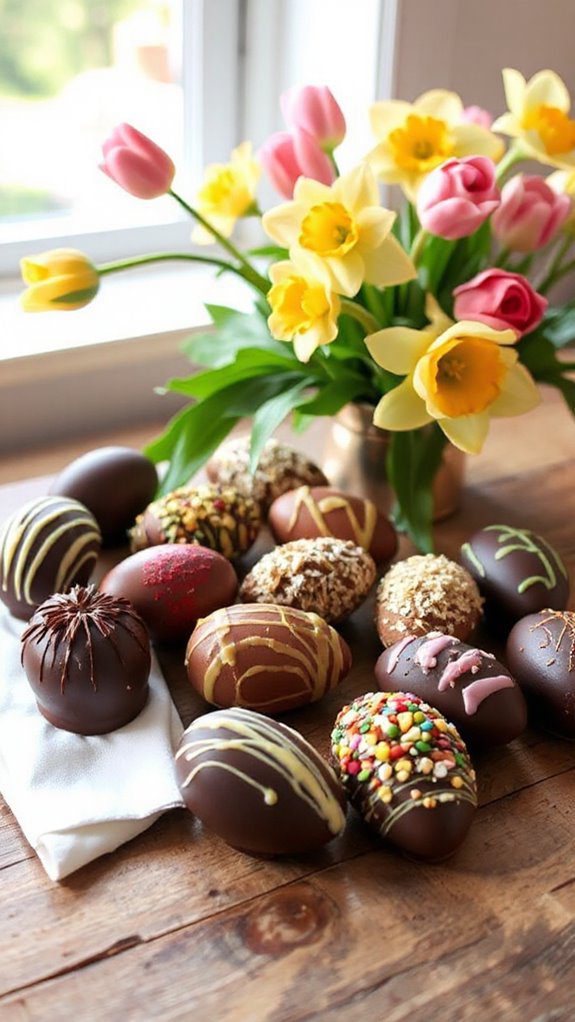
Springtime celebrations often bring an array of delightful festive treats that harmonize perfectly with the joy of the season. Among the favorites are vibrant and flavorful options that elevate any Easter gathering.
- Festive cupcakes adorned with pastel-colored frostings and topped with sprinkles
- Seasonal cookies in playful shapes like bunnies, eggs, and flowers
- Chocolate nests filled with candies for an interactive dessert
- Mini cheesecakes flavored with lemon or raspberry to awaken the palate
- Peeps marshmallows nestled within desserts for a whimsical touch
These treats not only please the eye but also tantalize the taste buds, making them essential for springtime festivities and a wonderful complement to homemade Easter chocolate eggs.
Troubleshooting
Navigating the intricacies of homemade Easter chocolate eggs can present its challenges, but with some thoughtful troubleshooting, success is within reach.
Common issues include seized chocolate or poor tempering, which can often be remedied with precise baking adjustments. For instance, if the chocolate thickens unexpectedly, gentle heating can restore its fluidity. Ingredient substitutions may also play a vital role; using high-quality chocolate or adjusting the cocoa content can affect both texture and flavor.
If egg molds are hard to release, consider lightly greasing them or letting the chocolate set at room temperature longer.
Conclusion
The joy of crafting homemade Easter chocolate eggs lies in the satisfaction of creating a delightful treat that can be shared with loved ones. This hands-on experience fosters connection and reflects cherished Easter traditions, steeped in the spirit of giving and togetherness.
Families gather, blending creativity with chocolate, transforming simple ingredients into treasures embodying love and care. Beyond their exquisite taste, these eggs carry profound chocolate symbolism, representing renewal and the sweetness of life.
Homemade creations elevate the holiday, offering a personal touch that store-bought alternatives cannot replicate. Ultimately, indulging in homemade Easter chocolate eggs is not merely about satisfying a sweet tooth; it is about celebrating moments that matter and weaving rich memories together in every bite.

